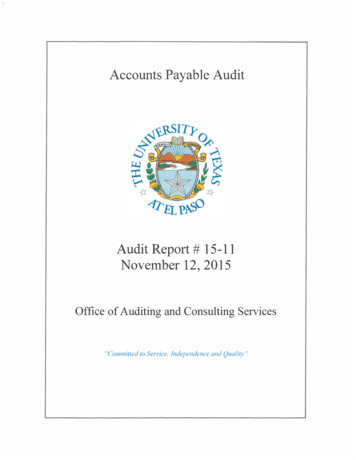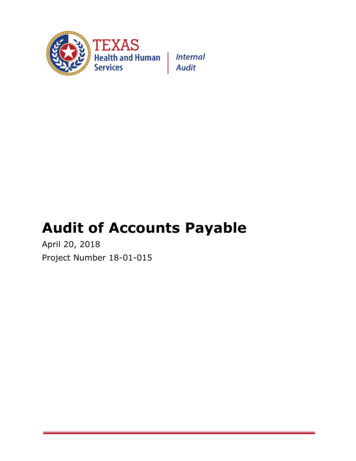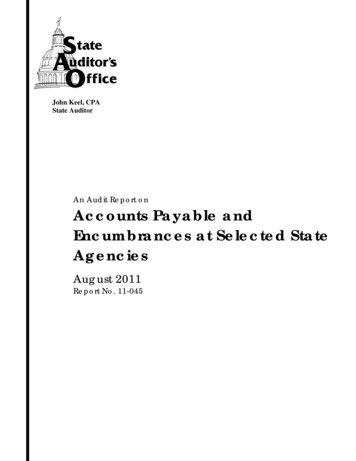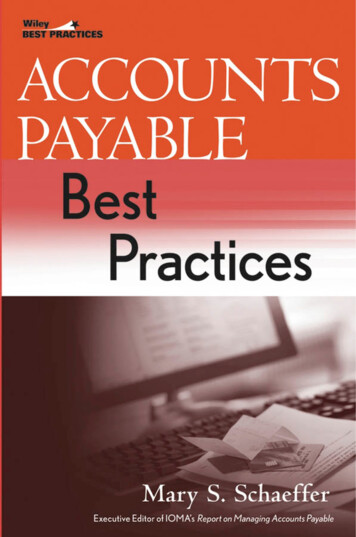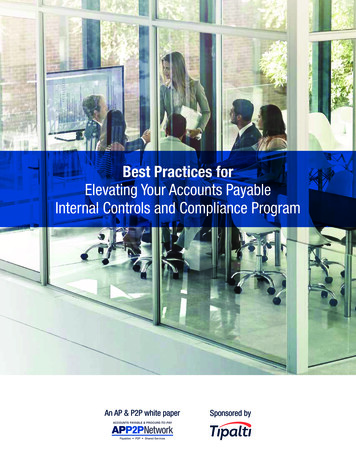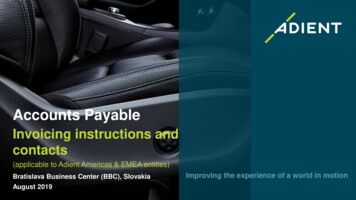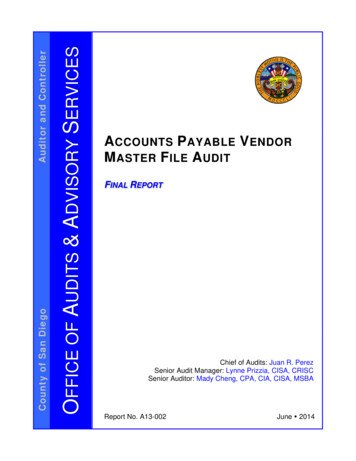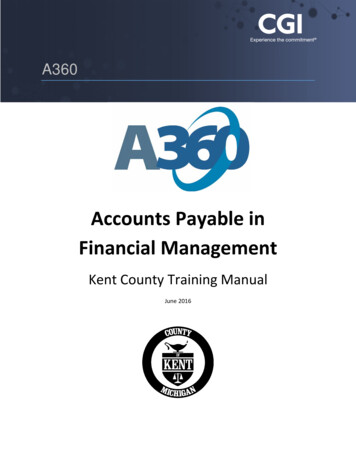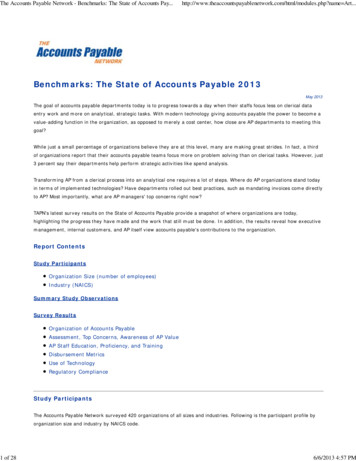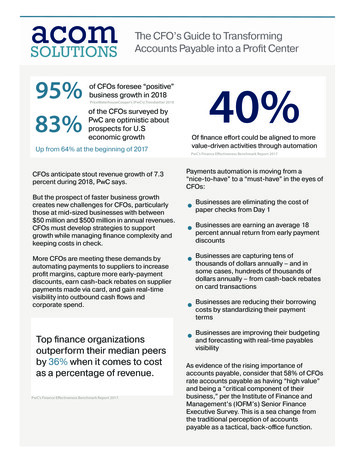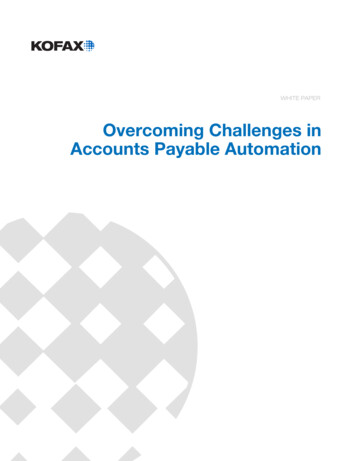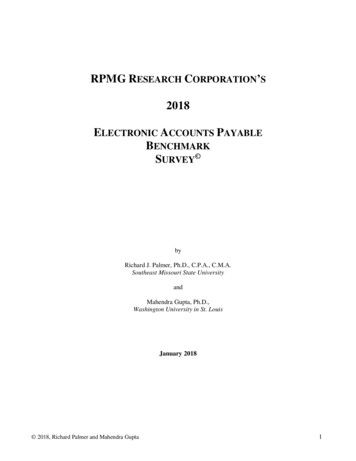
Transcription
RPMG RESEARCH CORPORATION’S2018ELECTRONIC ACCOUNTS PAYABLEBENCHMARKSURVEY byRichard J. Palmer, Ph.D., C.P.A., C.M.A.Southeast Missouri State UniversityandMahendra Gupta, Ph.D.,Washington University in St. LouisJanuary 2018 2018, Richard Palmer and Mahendra Gupta1
2018 ELECTRONIC ACCOUNTS PAYABLE BENCHMARK SURVEY TABLE OF CONTENTSSection1234567891011121314151617TitlePage #Introduction .Confidentiality Agreement and Consent to Use .Demographic Data .EAP Program Description .Supplier Enablement and Retention .Capture and Payment Preferences .EAP Purchase Activity and Impact on Other Payment Methods .EAP Category Spending Capture .Past Changes in EAP Spending .Expected Changes in EAP Spending .Value and Benefits of EAP .Integration .Program Management .Mobile Technology, Blockchain, and E-Procurement .Global EAP Payments .EAP and Fraud .EAP Provider Selection and Interaction .Satisfaction with EAP Provider .About the Authors . 2018, Richard Palmer and Mahendra Gupta030405081214161819202224252627282930332
IntroductionWelcome to the 2018 Electronic Accounts Payable Benchmark Survey. The survey is designed to understand andadvance the successful use of Electronic Accounts Payable (EAP or virtual cards). Eighteen major financialinstitutions in the U.S. and Canada, as well as the National Association of Purchasing Card Professionals aresupporting and participating in this study. There is no charge for participation. A strict confidentiality agreementis enforced and included on the next page.BENEFITS OF PARTICIPATIONIn recognition of your contribution of time and effort, organizations completing this survey will receive free ofcharge the following:1. A PDF copy of the 2018 Electronic Accounts Payable Benchmark Survey Results, will be sent oncompletion of the survey.2. A PDF copy of the 2015 Electronic Accounts Payable Benchmark Survey Results downloadableimmediately upon completion of this survey.3. The first 400 respondents who complete the survey will also be awarded with an Amazon.com giftcertificate ( 100 for the first 50, 50 for the next 100, and 25 for the next 250).The 2018 Results will include current market information and expert analyses that will provide your organizationwith:oBenchmark norms that will support a "segment-specific" self-assessment of performance and rationalizedialogues about financial incentives,o"Best practice" insights and customer commentary to assist in the development of strategies to optimizespending and derive the greatest value from EAP,oMarket trend information to add depth in the case to top management about the benefits of EAP, andoInformation that assists in the "day-to-day" management of administrative activities and control choicesassociated with EAPIMPORTANT SURVEY INSTRUCTIONSThis survey is an in-depth examination of how organizations use and involve EAP in the procure-to-pay process.Participants will derive the greatest benefit if all questions are answered. Most questions can be answered by theEAP program administrator with simple selections or by providing common statistics. With the exception of afew required questions, if any question does not apply to your organization or if the answer is unavailable for anyreason, simply leave the item blank. Completion of the survey should take approximately 35-75 minutes,depending on information availability.If you have any questions about the survey, contact Professor Richard Palmer by email(richard.palmer@RPMGresearch.net) or phone (618.559.5137).Please mail this completed survey to:RPMG Research Corporation1616 West Main StreetSuite 502Marion, IL 62959 2018, Richard Palmer and Mahendra Gupta3
Confidentiality Agreement and Consent to UseRPMG Research Corporation maintains a policy of strict confidentiality with respect to your responses to thissurvey. RPMG Research Corporation, its employees and agents, shall keep all individual responses to the “2018Electronic Accounts Payable Benchmark Survey” confidential and shall not disclose the responses to any personor other entity. In addition, all information, analysis, responses, and other data that is specific to or identifies aspecific EAP provider shall be kept confidential and only released to that specific provider. This confidentialityagreement will apply to any person in the employment of or assisting RPMG Research Corporation in the analysisof survey data or compilation of survey results. Notwithstanding the fact that individual responses are and shallremain confidential, the aggregated responses of survey participants shall be made public in benchmark results,professional presentations, and published and unpublished documents authored by RPMG Research Corporationpersonnel bound by this agreement.By providing responses to this survey, you agree to allow RPMG Research Corporation to combine your responsewith others to create survey reports, presentations, and other analyses that describe best use and value deliveredby Electronic Accounts Payable. (Required) Agree Do Not AgreeNote: Without consent, you may not participate in the survey. If you would like to obtain more information aboutthe survey or our benchmark reports, please contact Professor Richard Palmer by email(richard.palmer@RPMGresearch.net) or phone (618.559.5137).Please note:The 2018 Electronic Accounts Payable Benchmark Survey, including questions and other content herein, is thecopyrighted work of Richard Palmer and Mahendra Gupta of RPMG Research Corporation. Any use orduplication of the questions or content of this survey without the express written consent of the authors will be aviolation of United States copyright law. 2018, Richard Palmer and Mahendra Gupta4
SECTION 1: Demographic DataIntroductory Note: Throughout this survey, we will inquire about your organization’s use of “ElectronicAccounts Payable” (EAP).We define EAP as any non-plastic commercial card account with a “dynamically-adjustable” credit limitassigned to match the amount of each transaction. It is typically used in the process to pay for goods and servicesafter an invoice has been received. There is no limit to the type of goods or services that may be paid in thismanner (including, but not limited to office supplies, computers, equipment, inventory, business services, travel,etc.). EAP may be referred to as “virtual cards,” “ePayables,” “single-use accounts,” “virtual payables,”“buyer-initiated payments,” “straight-through processing,” or other similar terms. Traditional ghost cardaccounts (with preset fixed credit limits) are not considered EAP.1.Does your organization use “electronic accounts payable” (EAP) to pay suppliers? (Required) Yes NoIf you answered “No,” please see message below. Otherwise, continue with Question 2(a).Due to your organization’s lack of EAP use, this is the end of your survey.If you would like to obtain more information about the survey or our other commercial card benchmarkreports, please contact Professor Richard Palmer by email (Richard.Palmer@RPMGresearch.net) orphone (618-559-5137).2(a).Information about the person responsible for completion of the survey:Name:Job Title:Phone number: ( ) - Extension (if applicable):2(b).Your organization-assigned email address (Required)*:* In order to receive the free PDF copy of the 2018 Electronic Accounts Payable Benchmark SurveyResults and early response gift certificates (if applicable), you must provide your email address at yourorganization. Personal email addresses will not be accepted.2(c).Would you like to be notified about future RPMG commercial card surveys and reports?3(a).Information about your organization: Yes NoOrganization name:City: State, province, or territory:Country: United States Canada OtherFor “Other,” please see message below, and then continue on. Otherwise, skip to Question 3(b).A note on currency:This survey asks questions related to EAP spending, controls, and organizational revenue in U.S. dollars. As amatter of uniformity and to ensure quality data, please adjust your organization’s figures to its equivalent in U.S.dollars. 2018, Richard Palmer and Mahendra Gupta5
3(b).What is the name of the primary bank or financial institution that provides your organization with most orall of its EAP products? American Express Bank of America Merrill Lynch Barclays BBVA Compass BMO Harris Bank BNP Paribas Capital One Citibank Comdata Commerce Bank3(c). Fifth Third Bank First National Bank of Omaha HSBC JPMorgan Chase Lloyds Bank PNC Bank Regions Bank Scotiabank Silicon Valley Bank SunTrust Bank Synovus TD Bank UMB Union Bank US Bank US Bank Canada Wells Fargo WEX Zions Bank Other (please name):Identify the brand associated with the primary EAP product used by your organization (select one): American Express Visa MasterCard Other (please identify):3(d). Does your organization use any additional EAP providers Yes (please identify):other than the primary provider selected above? No4.Please select the best description of your organization (please select one): (Required) Public corporation Privately-owned corporation Public college or university Private college or university School district State/province or state/provincial government agency City/county or city/county government agency Federal government agency Not-for-profit organization Other (please describe):If you chose “public corporation,” “privately-owned corporation,” or “other,” please answer Questions4(a) and 4(b) on the next page; otherwise skip to Question 5. 2018, Richard Palmer and Mahendra Gupta6
4(a). Please select the best description of your company’s geographic footprint. A North American company with all operations and sales in North America A North American company with operations and sales to customers outside of North America A non-North American company with operations and sales in North America A non-North American company with all operations and sales outside of North America Other (please describe):4(b).Please select the one industry classification that best describes your company: Administrative and support services Advertising and marketing Agriculture, forestry, and fishing Arts and entertainment Automotive retailing and service Construction Educational services Finance, insurance, and banking Food service and restaurants Hospitals Lodging and hospitality Management of facilities/companies Manufacturing Mining, oil and gas extraction, pipeline,and refining services Pharmaceuticals Publishing and media Professional, scientific, and technical services Real estate, rental, and leasing services Social services Software and information technology Telecommunications and data processing services Transportation Tourism and leisure Utilities (gas, electrical, and water) Warehousing and distribution services Wholesale and retail trade Other (please describe):5.Please provide a brief description of your organization’s business activities and/or primaryproduct/service:6.Please provide the number of employees at your organization: (Required)7.What is your organization’s approximate annual revenue (or budget for governmental and not-forprofit entities) for the last complete year? (Required) Less than 1 million 1 million to 9.9 million 10 million to 24.9 million 25 million to 99.9 million 100 million to 299.9 million 300 million to 499.9 million 500 million to 999 million 2018, Richard Palmer and Mahendra Gupta, , 1 billion to 1.9 billion 2 billion to 4.9 billion 5 billion to 9.9 billion 10 billion to 20 billion Greater than 20 billion Not sure7
SECTION 2: EAP Program Description8. Please identify the types of EAP platforms used by your organization. (A response to each platform isrequired)Common Types ofEAP PlatformsVirtual accountsmaintained by supplierVirtual accountsmaintained by buyerSingle-use or rotatingpool of accountsBuyer-initiatedpayments or straightthrough processingOtherDescription of PlatformFixed account number assigned to a specific supplier and heldin trust by that supplier, who charges the account to receivepayment for approved invoices.Fixed account number is assigned to a specific supplier, but notheld by that supplier. The account number is transmitted to andcharged by the supplier at time of payment.Randomly generated account number is transmitted to andcharged by the supplier at the time of payment.Card account is charged on behalf of the supplier, resulting infunds being deposited in the supplier’s bank account. Suppliersdo not initiate the transaction or input card data.(please describe below if used)Does YourEAP ProgramInclude thisPlatform? Yes No Yes No Yes No Yes Yes No NoPlease describe your organization’s other EAP platform if selected above:9.10.Average monthly spending on EAP (all platforms combined)currently is: (Required)*Average number of monthly transactions on EAP (allplatforms combined) currently is: (Required) * , , .00, ,* If the most recent month of EAP activity is not representative of your typical activity, please report yourspending and number of transactions for an average ------------------------------------------- 2018, Richard Palmer and Mahendra Gupta8
11(a). Please provide the percentage of combined monthly EAP spending that is conducted on each of the EAPplatforms below.Percentage of Combined Monthly EAPSpending on PlatformType of EAP PlatformVirtual accounts maintained by supplierVirtual accounts maintained by buyerSingle-use or rotating pool of accountsBuyer-initiated payments or straight-through processingOtherTOTAL (should sum to 100%)%%%%%100%11(b). Please select the dollar range that best represents the average transaction amount for each EAP platform.If a platform is not used, please select “N/A.”Average Transaction AmountN/A (platform is not used) 1 to 1,000 1,001 to 2,000 2,001 to 3,000 3,001 to 4,000 4,001 to 5,000 5,001 to 6,000 6,001 to 7,000 7,001 to 8,000 8,001 to 9,000 9,001 to 10,000 10,001 to 15,000 15,001 to 20,000 20,001 to 40,000Greater than 40,00012.Virtualaccountsmaintainedby supplierVirtualaccountsmaintainedby buyerSingleuse orrotatingpool ofaccountsBuyer-initiatedpayments orstraight-throughprocessingOtherPlease select the answer that best completes the sentence:Compared to purchases my organization makes with plastic cards, EAP purchases are for goods and services of the same type and dollar amount goods and services that are different N/A; my organization does not use plastic cardsFor “goods and services that are different,” please answer Question 12(a). Otherwise, skip to Question 13. 2018, Richard Palmer and Mahendra Gupta9
12(a).Please describe how purchases via EAP differ from purchases via plastic cards (select all that apply)Compared to purchases my organization makes with plastic cards, EAP purchases are for goods and services of higher dollar values for purchases from suppliers with whom the organization conducts a high number of transactions for goods and services which are not allowed to be paid by plastic cards for transactions requiring additional approvals or controls prior to payment different in other ways (please describe):13.What is the largest single transaction paid by any EAP platform at your organization in the past year? 10,000 or less 10,001 to 50,000 50,001 to 100,000 100,001 to 200,00014.How long has your organization been using EAP? Less than one year 1-2 years15. 200,001 to 300,000 300,001 to 500,000 500,001 to 1,000,000 More than 1,000,000 (please specify): 3-4 years 5-6 years 7-8 years 9-10 years 11-12 years 13 years or more Yes NoDoes your organization use EAP to its full potential?For “No,” please answer 15(a). Otherwise skip to 16.15(a). Please select the answer that best completes the sentence:EAP spending at my organization would be if we used EAP to its full potential. 50% higher 2-3 times higher16. 4-5 times higher 6-7 times higher 8-9 times higher 10-11 times higher 12-15 times higher more than 15 times higherDoes your organization’s use of EAP occur within an “integrated payables solution”where the bank or EAP provider enables payments to suppliers through multiplepayment channels, based on rules reflecting your organization’s preferences? Yes NoFor “No,” please answer 16(a). Otherwise skip to 17.16(a). Does your organization plan to use an “integrated payables solution” in the nextthree years? 2018, Richard Palmer and Mahendra Gupta Yes No10
17. Please rate the degree to which EAP has been valuable in delivering outcomes to your organization.OutcomeValue of EAP inDelivering OutcomeWhere:1 Not valuable2 Slightly valuable3 Moderately valuable4 Very valuable5 Extremely valuableEnhance financial position(e.g., improve working capital/cash flow, obtain rebates, obtain early paymentdiscounts, avoid late fees, etc.) 1 2 3 4 5Reduce reliance on checks 1 2 3 4 5Improve organizational processes(e.g., increase administrative efficiency, simplify spend reconciliation process,improve integration with accounting systems, etc.) 1 2 3 4 5Increase spending transparency(e.g., improve payment tracking, obtain data not consistently provided by otherpayment methods, consolidate spending across multiple units/systems, etc.) 1 2 3 4 5Enhance cybersecurity 1 2 3 4 5Strengthen control over spending(e.g., reduce potential for waste or abuse) 1 2 3 4 5 2018, Richard Palmer and Mahendra Gupta11
SECTION 3: Supplier Enablement and Retention18.Approximately how many suppliers does your organization currently pay with EAP? Less than 10 10 to 25 26 to 50 51 to 100 101 to 250 251 to 400 401 to 500 More than 500(please specify):19.Please estimate the percentage of your organization’s supplier base that c
Welcome to the 2018 Electronic Accounts Payable Benchmark Survey. The survey is designed to understand and advance the successful use of Electronic Accounts Payable (EAP or virtual cards). Eighteen major financial institutions in the U.S. and Canada, as well as the National Association of Purchasing Card Professionals areFile Size: 827KB
